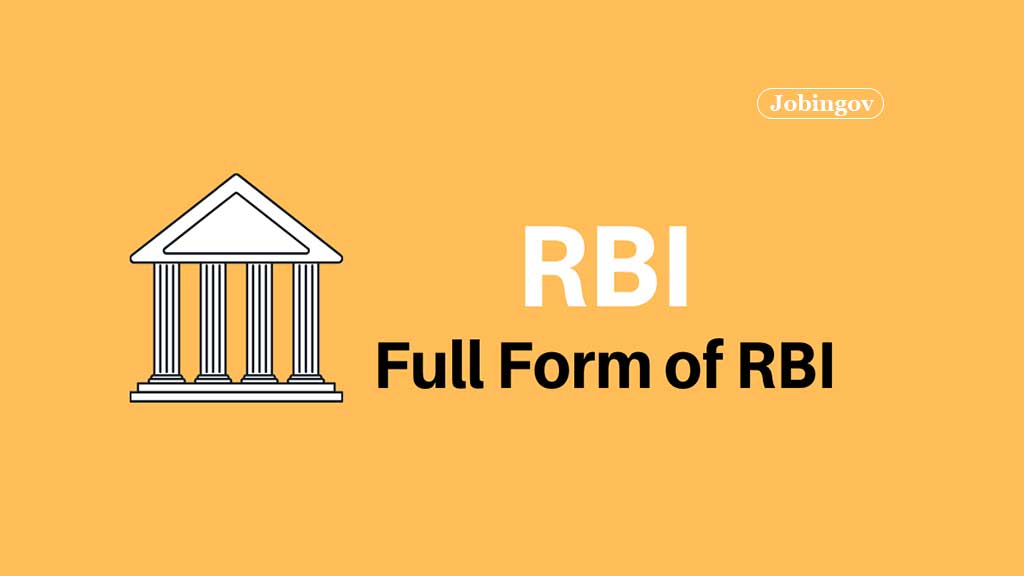RBI Full Form: Reserve Bank of India
Every nation has its own central bank that regulates all the banks set up in that country and for India RBI i.e. Reserve Bank of India plays the same role and is known as India’s central bank as well as banker’s bank.
It was come into existence on April 1, 1935 under the provisions of the Reserve Bank of India Act, 1934. It regulates certain things that is monetary policy, national currency i.e. Indian rupee.
To maintain the financial stability in India Reserve Bank of India use their monetary policy.

It is a very important topic from exam point of view and a lot of questions are asked from this topic in various competitive exam. In this article, we have discussed some important point that are asked very frequent.
Related Post: Important full form of Banking Terms
About RBI
RBI is a central banking organization of India of national importance as well as the pillar of Indian economy. It has a membership of the International Monetary Fund (IMF).
- In the book “The Problem of the Rupee – Its origin and its solution” formulated by Dr. Ambedkar has the basic concept of Reserve Bank of India.
- Credit and currency is regulated by the RBI.
- Through cooperative banking and commercial banking, RBI gain the confidence of public in their banking system, interest of the depositors, and also avail banking services within their ability.
History of RBI
In the history of RBI, we have to know how it came into existence and the way it gets its present shape. After 1919, many banks were set up but there were no government bank India at that time.
All the banks were private and there were no organization which controls this banks. They all were running their own bank according to their own rules and regulations and also there were people encounter lots of fraud incidents. Driven by the complaint received by the then British Government, they determined to formed a central body which will control all the other banks in India.
Timeline:
1920: A committee was formed in 1920 named Hilton Young committee. This committee is also known as Royal commission.
1926: The Hilton Young Committee submitted its report in 1926 and suggested, there should be central bank in India which control the other banks.
1927: The report was introduced in the Legislative Assembly to make it a law. But many people disagree with it and was later withdrawn.
1933: A newly fresh bill was prepared and introduced in the Legislative Assembly with the recommendation of Indian Constitutional reforms to create a Reserve Bank.
1934: With the assent of the Governor General’s, the bill become an act.
1935: On April 01, 1935, operation of the India’s central bank was commenced by the Reserve Bank with a paid up capital of Rs 5 Cr of private shareholders’.
1942: Currency issuing authority for Burma (present name Myanmar) was ceased by the Reserve Bank in this year.
1947: The Reserve Bank discontinue as banker to the Burmese government.
1948: The Reserve Bank stopped their banking services in Pakistan.
1949: On January 01, 1949, it got nationalization under the Reserve Bank (Transfer of Public Ownership) Act, 1948 by Government of India. Here, RBI was obliged to obey the instruction of the Government of India.
2016: The RBI Act of 1934 was amended in 2016, in which the flexible inflation-targeting framework was implemented.
Functions of RBI
The functions of RBI are as follows:
- It is act as an agent of issuing the currency and coins except one-rupee currency and coin (issued by Ministry of Finance and signature by the Finance Secretory on the note).
- It is act as the agent of distribution of currency and coins that is issued by the government of India.
- Banker of the government.
- Bank of the banks.
- Control the rate of inflation.
- Regulate the exchange rate of rupee.
- Keeps the foreign currency reserves.
- A member of IMF in regards of the government of India.
- Perform various developmental operations.
- Regulate the other banks and financial system with certain methods as: License issuing, Liquidity of assets, Bank mergers, Branch expansion.
More Full Forms:
| BBA Full Form | MBA Full Form |
| AIIMS Full Form | NCERT Full Form |
| ATM Full Form | INR Full Form |
| IFSC Full Form | CIO Full Form |
The central board of directors controls the Reserve Bank of India. At the top of which is governor of Reserve Bank of India who is the executive head nominated for 4 years.
Follow us on Facebook and Twitter.
RBI Full Form: FAQs
Q1. Who is the owner of RBI?
Ans: Initially it was owned privately but after nationalization of RBI on January 01, 1949, Government of India takes the ownership of RBI.
Q2. What does the contingency fund indicate?
Ans: RBI maintains the contingency fund (CF) to sustain in an unexpected emergency. RBI transfers the surplus amount after meeting the expenses of their own to the government of India. Generally, surplus amount is the amount of income that RBI earns with their various kinds of securities it possesses.
Q3. Who is the executive head of RBI?
Ans: The governor of RBI is the executive head of the RBI who is appointed for 4 years.
Q4. Which commission recommended for the formation of RBI?
Ans: The Hilton commission also known as Royal commission recommended for the formation of a central bank i.e. RBI.
Q5. On which year RBI got nationalization?
Ans: On January 01, 1949, RBI got nationalization.
Q6. Which bank is the central bank of India?
Ans: Reserve Bank of India (RBI) is the central bank of India.





